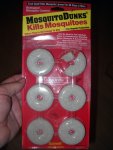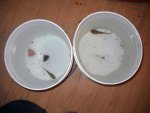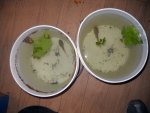eyrops
Member
I have been interested in using [FONT="]Bacillus thuringiensis [/FONT][FONT="]in an outdoor amphibian setup to kill mosquito larvae. Mosquitoes have become more than a nuisance issue in many portions of the US because they have the potential to be carriers of West Nile virus, which can be serious and occasionally fatal for humans. I recently read of a New York City resident who was fined about $300 for operating a birdbath. While this incident is certainly not typical today in most places, the mentality that created it is on the rise. I believe that controlling mosquitoes in some manner is a responsibility of a hobbyist setting up an outdoor amphibian enclosure. One method would be to stock an organism that would eat the mosquito larvae. This may be a viable approach if the right organism for the particular setup can be found. I am not discussing this approach here. A second approach could be to use a pesticide that targets mosquito[/FONT][FONT="]es without being detrimental to the amphibians. One possibility for this is the bacteria[/FONT][FONT="]Bacillus thuringiensis[/FONT][FONT="]. [/FONT][FONT="]These bacteria can be deadly to mosquitoes and many other insects, and is commonly claimed to be allowable under the “organic” gardening and farming umbrella. But what effect do they have on amphibians? I had not found very much information on Caudata.org or elsewhere. I decided to do a very simple qualitative trial with two [/FONT][FONT="]Rana catesbeiana[/FONT][FONT="]tadpoles.[/FONT]
[FONT="]I put each in a bucket with about 1 ½ gallons of water. I added a commercia[/FONT][FONT="]l[/FONT][FONT="]Bacillus thuringiensis[/FONT][FONT="]product to one at a visual approximation of the recommended rate. I added some [/FONT][FONT="]Daphnia[/FONT][FONT="] to both buckets. Five days later, both tadpoles are alive, and both buckets contained living [/FONT][FONT="]Daphnia[/FONT][FONT="]. [/FONT][FONT="] Concurrently, I set up two pint jars with mosquito larvae, on with[/FONT][FONT="]Bacillus thuringiensis[/FONT][FONT="], a[/FONT][FONT="]nd one without. The mosquito larva in the jar with the[/FONT][FONT="]Bacillus thuringiensis [/FONT][FONT="]died within 24 hours. There were still a few pupae alive. These were not evident after 48 hours. The larvae in the untreated jar appeared fine.[/FONT]
[FONT="]This was a simple qualitative trial, not a quantitative experiment with replicates. It proves nothing except that[/FONT][FONT="]Bacillus thuringiensis[/FONT][FONT="]is not universally fatal to [/FONT][FONT="]Rana catesbeiana[/FONT][FONT="]tadpoles over the short term. I think it does suggest possibilities for more formal experiments. Although it seems cold and calculating, it also seems to me to be work that needs to be done. I hope to learn the experiences of others, and perhaps see some links to scientific papers on the topic posted here.[/FONT]
[FONT="]I put each in a bucket with about 1 ½ gallons of water. I added a commercia[/FONT][FONT="]l[/FONT][FONT="]Bacillus thuringiensis[/FONT][FONT="]product to one at a visual approximation of the recommended rate. I added some [/FONT][FONT="]Daphnia[/FONT][FONT="] to both buckets. Five days later, both tadpoles are alive, and both buckets contained living [/FONT][FONT="]Daphnia[/FONT][FONT="]. [/FONT][FONT="] Concurrently, I set up two pint jars with mosquito larvae, on with[/FONT][FONT="]Bacillus thuringiensis[/FONT][FONT="], a[/FONT][FONT="]nd one without. The mosquito larva in the jar with the[/FONT][FONT="]Bacillus thuringiensis [/FONT][FONT="]died within 24 hours. There were still a few pupae alive. These were not evident after 48 hours. The larvae in the untreated jar appeared fine.[/FONT]
[FONT="]This was a simple qualitative trial, not a quantitative experiment with replicates. It proves nothing except that[/FONT][FONT="]Bacillus thuringiensis[/FONT][FONT="]is not universally fatal to [/FONT][FONT="]Rana catesbeiana[/FONT][FONT="]tadpoles over the short term. I think it does suggest possibilities for more formal experiments. Although it seems cold and calculating, it also seems to me to be work that needs to be done. I hope to learn the experiences of others, and perhaps see some links to scientific papers on the topic posted here.[/FONT]



